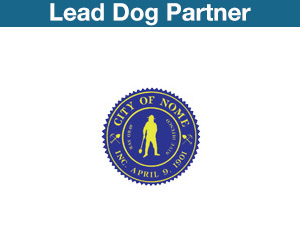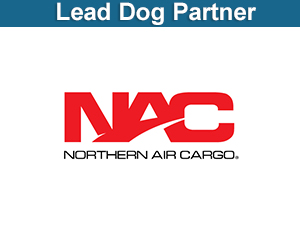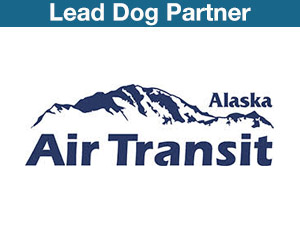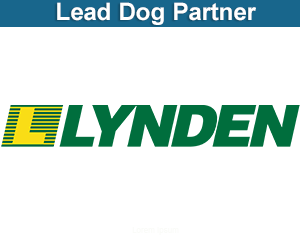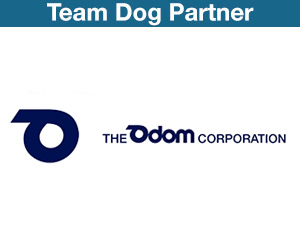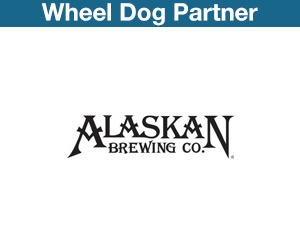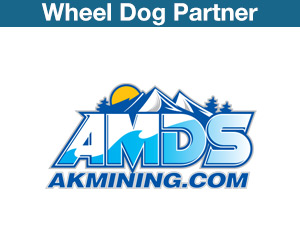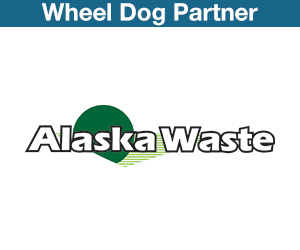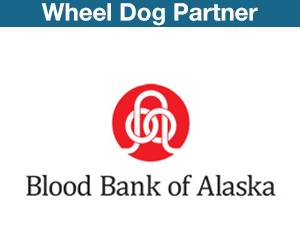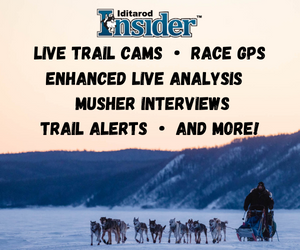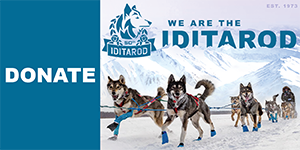by Stuart Nelson, Jr., DVM
Veterinarians and mushers must be prepared to respond appropriately to temperature extremes as part of good dog care on the trail. Calm and sunny days on a snow-covered (reflective) landscape with moderating temperatures, can create an environment conducive to hyperthermia (overheating). In contrast, very low ambient temperatures combined with wind-chill factors and the ever present risk of becoming wet (such as in overflow conditions), could quickly result in hypothermia (chilling). Homeostasis in mammals is achieved by a delicate balance of thermoregulatory mechanisms largely controlled by a part of the brain known as the hypothalamus. A discussion of these mechanisms is appropriate for understanding the rationale used in prevention and treatment.
Cooling of a dog results from decreased heat production and/or increased heat loss. The former typically is a response to lowered metabolic rate, i.e. reduced energy intake (decreased appetite), or diminished muscular activity (resting). In the quiet animal, skeletal muscle contributes about 25% of the total heat produced. Other metabolic heat sources are primarily the liver, brain and heart.
Heat loss or dissipation occurs via four basic forms: radiation, (water) evaporation, convection (air movement) and conduction (contact). The physiological functions designed to enhance heat loss include panting, vascular alterations (vasodilation), and sweating. Simply defined, radiation loss involves the transfer of heat as electromagnetic energy (infrared) from the sled dog to the atmosphere. Radiation is usually the largest type of heat loss, but may be highly variable. Cold, clear nights result in much greater radiation loss than bright days.
The second major method of heat dissipation is through evaporation. This is accomplished primarily by panting and salivation, as water is lost from the airways of the athlete. Since sweat glands of the dog are limited to the nose and foot pads, their role is much less in importance, particularly when booties are worn. Of course, a situation that results in the animal’s becoming wet will greatly increase the significance of evaporative heat loss. Some breeds have been banned from marathon races because of inadequate coats. Poodles, for example, have a propensity to collect ice balls on their hair, and when melting occurs, the wet animal becomes vulnerable to hypothermia.
Convective heat loss is also highly variable, depending primarily on wind conditions, speed of travel and respiratory rate (panting), but ordinarily amounts of about 12% in a static condition. Heat loss through conduction is usually relatively small (3%), but will become more significant as ambient temperatures drop and is most critical in cases of water immersion. Vasodilation is the physiological response most useful in utilizing these last two forms of heat transfer when cooling is required.
For the sake of avoiding redundancy, it may be assumed that factors contributing to warming of the sled dog are inversely related to those that create cooling. However, some specific points should be emphasized. In response to cooling body temperatures, the hypothalamus will enhance heat production through appetite stimulation, increased metabolism (assuming adequate caloric availability) and greater muscular activity (shivering, restlessness). This may help explain why some dogs will have more hearty appetites after resting (cooling) at a checkpoint for 1-2 hours. It has long been established that fats (versus carbohydrates) are the most desirable energy source available for the racing dog. Astoundingly, muscular exertion may increase metabolic heat production by as much as 60 fold!
One of the best methods of reducing heat loss is through body posture. As the dog rests in a tight curl, surface area is greatly reduced, which diminishes convective and conductive heat loss. The nose tucked under the tail serves to allow pre-heated air to enter the respiratory tract. Straw bedding is almost universally utilized by Iditarod mushers, which serves as an effective insulator from the snow surface, thus reducing conduction. I have seen the occasional dog that will create an insulated “bed” of its own from broken off spruce twigs! Radiant heat barriers (Space Blankets) are very effective tools used by mushers for reducing radiant (and convective) heat loss from their animals. Polypro blankets and jackets are used to reduce convective and conductive heat dissipation. Development of life-threatening hyperthermia (sustained temperatures greater than (107 F) is our greatest temperature related medical concern. Hyperthermia is most apt to occur when running during the heat of the day in ambient temperatures exceeding 0 F.
Mushers will strive to schedule major rest stops during the afternoon hours to avoid this risk. If situations necessitate travel at these times, mushers are aware of and closely observe for early signs, which can be resolved by merely stopping and offering cold water drinks. They are advised to carry rectal thermometers in their sleds for recording temperatures of suspect dogs. When in doubt, rectal temperatures can be compared with other dogs in the team. Assuming good health otherwise, dark colored, heavy coated and/or hard working dogs seem to the most susceptible. Progressing signs of increased respiratory rate, excessive salivation, rapid heart rate and bright red gingiva (gums) are typical of developing hyperthermia. Exaggerated open mouth breathing will become apparent as the condition becomes critical. Lowering the body temperature becomes an immediate treatment priority. This is best accomplished by immersion in cold water, or at least rubbing with snow. Veterinary medical assistance must be obtained at the first opportunity. A dog that has been treated for hyperthermia, even mild forms, must never continue in the race. Changes have occurred at the cellular level that predispose the animal to sudden collapse and death, if run soon afterward. However, a week’s worth of rest will enable the dog to race another day.
So, what is the best way to respond a situation where a dog has become immersed in overflow? Drying the animal is the first priority. This is often accomplished by merely give a dog the chance to stop and roll in the snow.
Loose snow will absorb the water relatively efficiently. Next, booties should be removed and replaced with dry ones. The exception to this would be the use of some of the newer bootie fabrics which are minimally absorbent, and therefore, retain little moisture anyway. Dogs can then be dressed in “jackets” to help retain body heat, particularly in high wind conditions. Finally, getting the team moving again to generate heat through muscular activity will be sufficient to maintain a normal body temperature. Education, prevention and committed sponsorship are keys to excellence in dog care.







